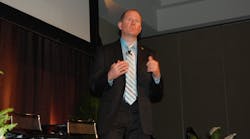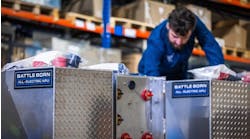LOUISVILLE, KY. Freight analysts, truck manufacturers and suppliers continue to think trucking remains on healthy footing, with steady tonnage and rising freight rates keeping truck sales strong for the remainder of the year.
“Our data suggests freight demand remains healthy; steady growth but flattening out now, with modest 3% to 4% growth in freight for 2015,” noted Eric Starks, president of research firm FTR Transportation Intelligence, during a Fleet Forum presentation at the Mid America Trucking Show.
“By 2016 we should see real record [freight] growth, with the strongest growth flatbeds between 2014 and 2016,” he said, adding that commodities freight – with food shipments making up 23% of those shipments – should witness 3% to 4% growth this year as well.
Starks also noted that his firm’s FTR trucking conditions index should “remain relatively healthy” for foreseeable future.
“Truck utilization is around 95% to 96%, which is good, but it’s easing off a bit recently,” he said.
Still, Class 8 order activity remains healthy, with FTR predicting 320,000 factory shipments of Class 8 units in North America for 2015, versus 295,000 units in 2014.
ACT Research Co. is forecasting a Class 8 build of 340,000 units for 2015, with the “extraordinarily strong” order volumes that occurred since the fall of last year leaving only approximately 105,000 available build slots for the remainder of the year.
As a result, Wall Street investment firm Stifel, Nicolaus & Co. thinks Class 8 orders may slow more during the seasonally slow middle months of the year than what many are anticipating, with few placed for 2016 delivery until there is clarity from OEMs on pricing.
According to ACT, OEMs typically quote prices for the upcoming model years in August, with negotiations taking place during September and the order season beginning in earnest starting in October. Therefore, Class 8 orders are likely to decelerate sharply the next several months as build slots become increasingly scarce for the remainder of 2015, Stifel noted.
Still, Stifel believes that while Class 8 orders may surprise to the downside in the coming months, orders could surprise to the upside as in October, once pricing has been established and fleets plan for their 2016 needs.
For their part, OEMs and suppliers are expecting Class 8 orders to remain robust at least through this year.
“All indicators are going positive from our perspective,” noted Preston Feight, gm for Kenworth Truck Co., during a press conference here at MATS. “U.S. gross domestic product [GDP] increased 2.4% last year, with tonnage up 3.5% to an all-time record and fleet profitability up 4.6%.”
Kenworth is projecting Class 8 sales for the U.S. and Canada will range between 250,000 and 280,000 units for the year, with Class 6-7 sales ranging between 65,000 and 75,000 units.
Feight added that truck utilization is currently at 91% while driver turnover is hovering around 80%, which while high, is “normalizing and thus not a crisis yet.”
Darrin Siver, gm for Peterbilt Motors Co., also thinks Class 8 sales for the U.S. and Canada will range between 250,000 and 280,000 units for 2015, with natural gas-powered trucks only making up 5% of that volume.
In the future, he thinks natural gas-powered equipment could potentially make up 10% of the Class 8 market, “but 25%? No.”
Göran Nyberg, president of Volvo Trucks North America, believes North American Class 8 sales with end up around 320,000 units for the year.
Joe McAleese, chairman, president and CEO for Bendix Commercial Vehicle Systems, noted that all of the indicators his company monitors to gauge the health of the U.S. economy and the trucking industry “are all green right now.”
McAleese noted in a presentation here at MATS that his 2014 projections for a 10% to 15% increase in North American commercial truck sales “ended up on the higher side of that prediction,” and he’s expecting another 15% to 20% increase in commercial vehicle sales for 2015.
“Unfortunately for 2016 I’m more of a pessimist,” McAleese added. “I think commercial vehicle sales will go a little soft, falling 5% to 7.5%, as 2015 proves to be the industry’s cyclical peak.”
Still, he noted that January’s freight tonnage ended up 6.6% higher than the same month in 2014. “We’re seeing record freight levels,” he noted. “Looking at the overall economic climate, everything looks pretty good.”



